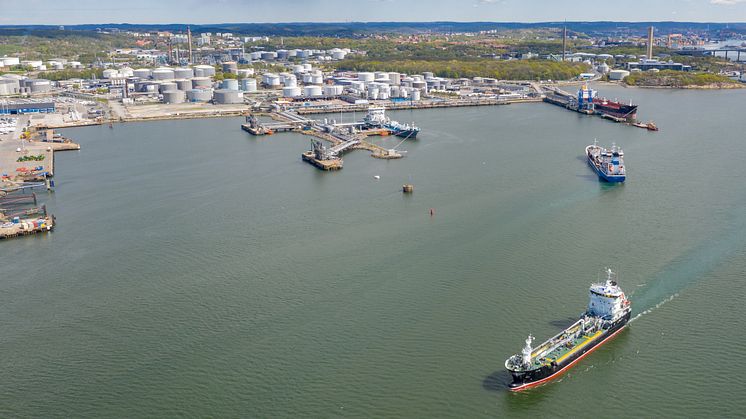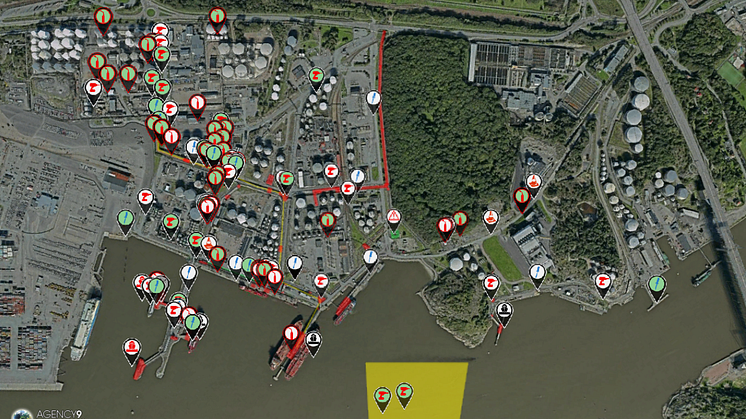
Press release -
Unique digital solution makes the Port of Gothenburg smarter
Quicker, safer, and less administration. These were some of the key outcomes when the Gothenburg Port Authority recently launched a data system designed to coordinate and monitor work at the Port of Gothenburg Energy Port. The ultimate outcome is more rapid and more efficient handling of goods.
The Port of Gothenburg Energy Port is the largest open access energy terminal in Sweden, handling more than 20 million tonnes of energy products annually. The 24 berths at the Energy Port can receive up to 2,500 vessels each year. On land, the same number of vehicles pass through the gates of the Energy Port every day.
“We operate in a high-intensity environment where safety is our first priority. Still, we need to handle large freight volumes and traffic flows quickly and efficiently. With smart automation and digitised processes, it is easier to solve that equation,” said Dan-Erik Andersson, Chief Operating Officer at the Gothenburg Port Authority Energy Port.
70 ongoing jobs every day
The most recent in a series of digital solutions is the launch of the unique data system Permesso, which was designed and developed in-house. The system allows work permits to be issued online and for planned and ongoing maintenance and development at the Energy Port to be coordinated digitally.
According to Carl Jansson, Safety and Security Coordinator at Gothenburg Port Authority, around 70 projects are in progress in various parts of the Energy Port on any given day. “It is vitally important that we have a clear overview of what’s going on. We can now simplify the issuing of permits to cover all the work that is being carried out on behalf of different customers and involving a large number of contractors.”
Time-saver for customers
The company or unit that is scheduled to carry out the work can now obtain a permit online instead of going all the way down to the Energy Port and dealing with the paperwork manually. Port Authority staff can approve a permit or request additional information directly on screen.
“Previously, it could take up to half a day to gather all the signatures. Now it takes just a couple of minutes. The new system saves an incredible amount of time and effort for customers, contractors, and not least for us,” said Emily Andersson, IT Project Leader at Gothenburg Port Authority.
When a permit is registered in the system, a symbol appears on a digital map of the Energy Port. Using the map, it is possible to maintain an overview of all the work that is being done and identify obstacles or risks to other operations or projects that are taking place in the vicinity. It is possible, for example, to coordinate hot work with the pumping of energy products without compromising onsafety.
In the event of an accident, the system can send the relevant coordinates directly to the emergency services, ensuring they know exactly where to go even if no one from the scene of the accident is on hand to guide them.
One of multiple digital projects
Permesso is the fourth in a series of digitisation and automation projects that have been launched in various parts of the Energy Port within a short period. In the last year alone, the Port’s pipeline management system has undergone extensive automation, ‘alco-barrier’ checkpoints have been established, and an app has been developed to make it easier for vessels to bunker at the quayside.
“We are constantly searching for ways to eliminate any unnecessary steps in the process and improve safety. Once we have achieved this, we can focus on our core operations, creating optimum conditions for rapid, efficient handling of goods at the Energy Port,” said Dan-Erik Andersson.
Topics
Fact file: Port of Gothenburg
The Port of Gothenburg is the largest port in the Nordic region. 30 per cent of Swedish foreign trade passes through the Port of Gothenburg as well as half of all container traffic.
The Port of Gothenburg is the only port in Sweden with the capacity to receive the world's largest container vessels and has the broadest range of shipping routes within and outside Europe. The 25 rail shuttles that depart each day mean that companies throughout Sweden and Norway have a direct, environmentally smart link to the largest port in the Nordic region. The Port of Gothenburg has terminals for oil, cars, ro-ro, containers and passengers.




